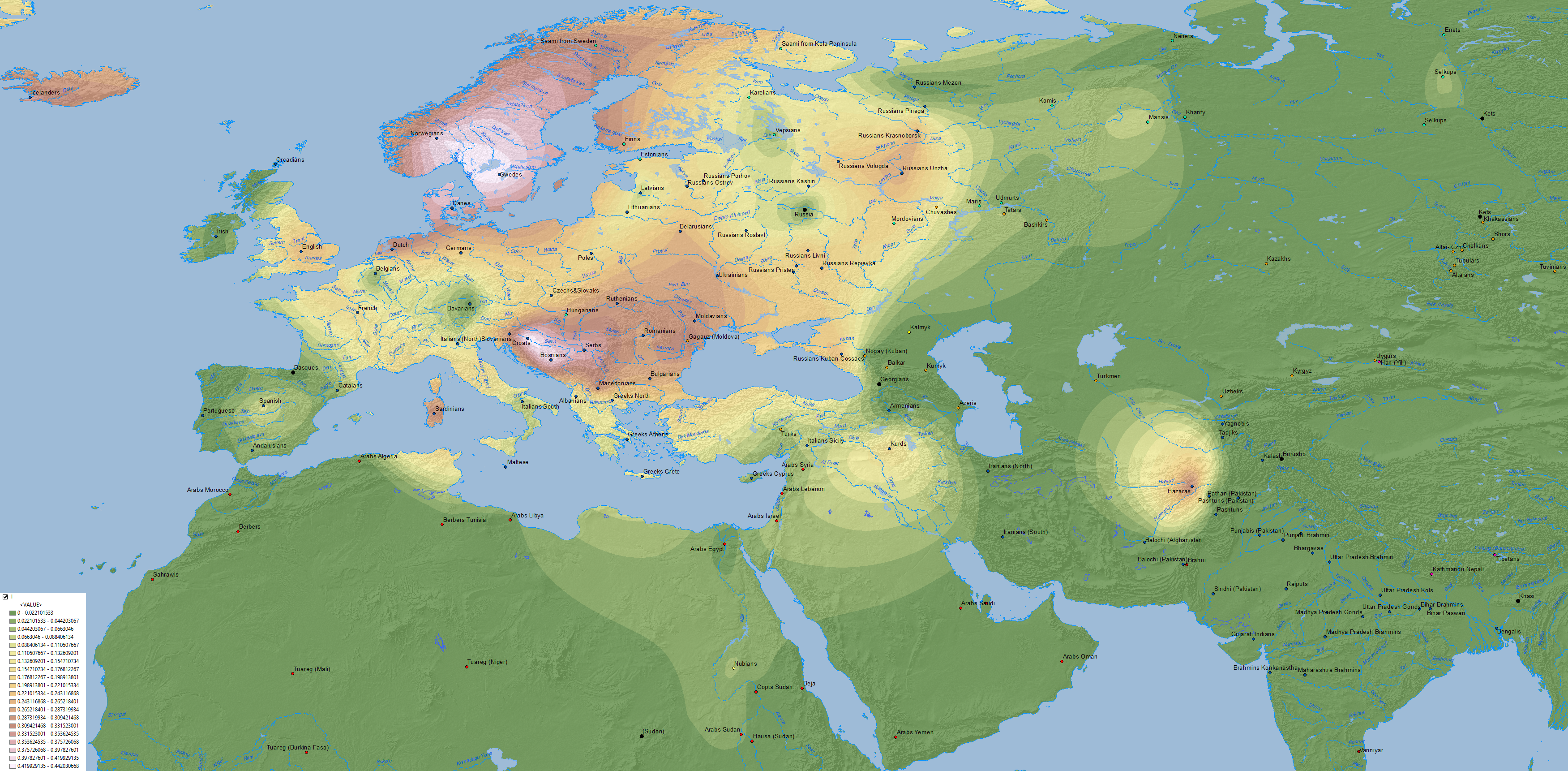7




























| Thumbs Up/Down |
| Received: 6,918/235 Given: 4,895/41 |


Like other Western Europeans, among Spaniards and Portuguese the Y-DNA Haplogroup R1b is the most frequent, occurring at over 70% throughout most of Spain. R1b is particularly dominant in the Basque Country and Catalonia, occurring at rate of over 80%. In Iberia, most men with R1b belong to the subclade R1b-P312. The distribution of haplogroups other than R1b varies widely from one region to another.
In Portugal as a whole the R1b haplogroups rate 70%, with some areas in the Northwest regions reaching over 90%.
Although R1b prevails in much of Western Europe, a key difference is found in the prevalence in Iberia of R1b-DF27. This subclade is found in over 60% of the male population in the Basque Country and 40-48% in Madrid, Alicante, Barcelona, Cantabria, Andalucia, Asturias and Galicia. R1b-DF27 constitutes much more than the half of the total R1b in the Iberian Peninsula. Subsequent in-migration by members of other haplogroups and subclades of R1b did not affect its overall prevalence, although this falls to only two thirds of the total R1b in Valencia and the coast more generally. R1b-DF27 is also a significant subclade of R1b in parts of France and Britain. R1b-U152 is the prevailing subclade of R1b in Northern Italy, Switzerland and parts of France, but it represents less than 5.0% of the male population in Iberia. Ancient samples from the central European Bell Beaker culture, Hallstatt culture and Tumulus culture belonged to this subclade. R1b-U152 is slightly significant in Seville, Barcelona, Portugal and Basque Country at 10-20% of the total population, but it is represented at frequencies of only 3.0% in Cantabria and Santander, 2.0% in Castille and Leon, 6% in Valencia, and under 1% in Andalusia.
Haplogroup J, mostly subclades of Haplogroup J2, is found at levels of over 20% in some regions, while Haplogroup E has a general frequency of about 10% – albeit with peaks surpassing 30% in certain areas. Overall, E-M78 and E-M81 both constitute about 4.0% each, with a further 1.0% from Haplogroup E-M123 and 1.0% from unknown subclades of E-M96. (E-M81 is widely considered to represent relatively historical migrations from North Africa).
Distribution of main haplogroups of Iberia:
R1b-DF27:
R1b-U152:
R1b-L21:
R1b-U106:
J2:
E-M78:
E-M81:
R1a:
I:

Last edited by Rocinante; 06-06-2020 at 10:25 AM.














| Thumbs Up/Down |
| Received: 3,352/194 Given: 5,348/287 |


Children of steppe invaders mating with iberian female : https://www.newscientist.com/article...tile-invaders/
























| Thumbs Up/Down |
| Received: 6,918/235 Given: 4,895/41 |














| Thumbs Up/Down |
| Received: 7,082/56 Given: 6,666/31 |


Very cool thread.
Another cool study on DF-27 is this one:
Characterization of the Iberian Y chromosome haplogroup R-DF27 in Northern Spain
Patricia Villaescusa, María José Illescas, Laura Valverde, Miriam Baeta, Carolina Nuñez, Begoña Martínez-Jarreta, Maria Teresa Zarrabeitia, Francesc Calafell, Marian M. de Pancorbo'Correspondence information about the author Marian M. de PancorboEmail the author Marian M. de Pancorbo
DOI: http://dx.doi.org/10.1016/j.fsigen.2016.12.013 |
http://www.fsigenetics.com/article/S...246-0/fulltext
not open access
Highlights
•A detailed dissection of R-DF27 paternal lineage is performed for the first time.
•DF27 haplogroup seems to have a geographical significance in the Iberian Peninsula.
•The TMRCAs suggest DF27 is a young lineage that arose 4176 ± 696 years ago.
•DF27 could be used to trace Iberian male migrations into the Americas.
•DF27 could be used to trace the biogeographic paternal origin of a forensic evidence.
Abstract
The European paternal lineage R-DF27 has been proposed as a haplogroup of Iberian origin due to its maximum frequencies in the Iberian Peninsula. In this study, the distribution and structure of DF27 were characterized in 591 unrelated male individuals from four key populations of the north area of the Iberian Peninsula through the analysis of 12 Y-SNPs that define DF27 main sublineages. Additionally, Y-SNP allele frequencies were also gathered from the reference populations in the 1000 Genomes Project to compare and obtain a better landscape of the distribution of DF27. Our results reveal frequencies over 35% of DF27 haplogroup in the four North Iberian populations analyzed and high frequencies for its subhaplogroups. Considering the low frequency of DF27 and its sublineages in most populations outside of the Iberian Peninsula, this haplogroup seems to have geographical significance; thus, indicating a possible Iberian patrilineal origin of vestiges bearing this haplogroup. The dataset presented here contributes with new data to better understand the complex genetic variability of the Y chromosome in the Iberian Peninsula, that can be applied in Forensic Genetics.














| Thumbs Up/Down |
| Received: 3,352/194 Given: 5,348/287 |
























| Thumbs Up/Down |
| Received: 6,918/235 Given: 4,895/41 |














| Thumbs Up/Down |
| Received: 3,352/194 Given: 5,348/287 |
























| Thumbs Up/Down |
| Received: 6,918/235 Given: 4,895/41 |
There are currently 1 users browsing this thread. (0 members and 1 guests)
Bookmarks